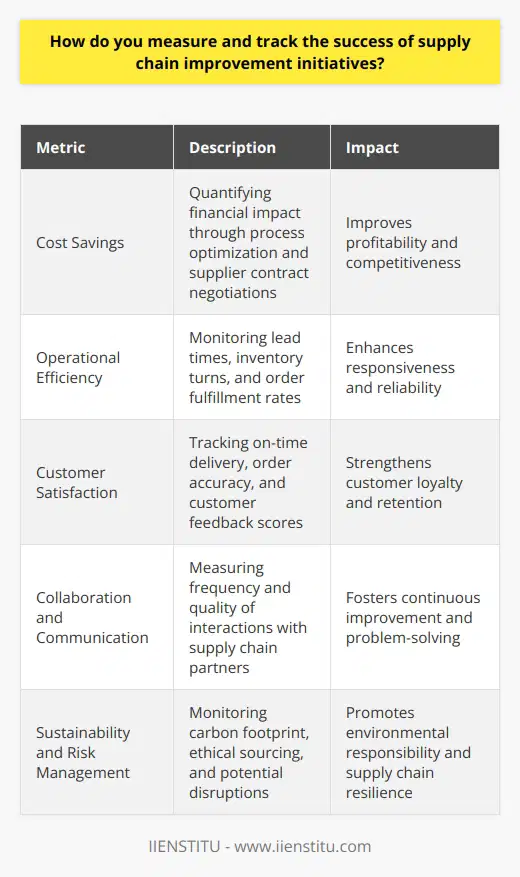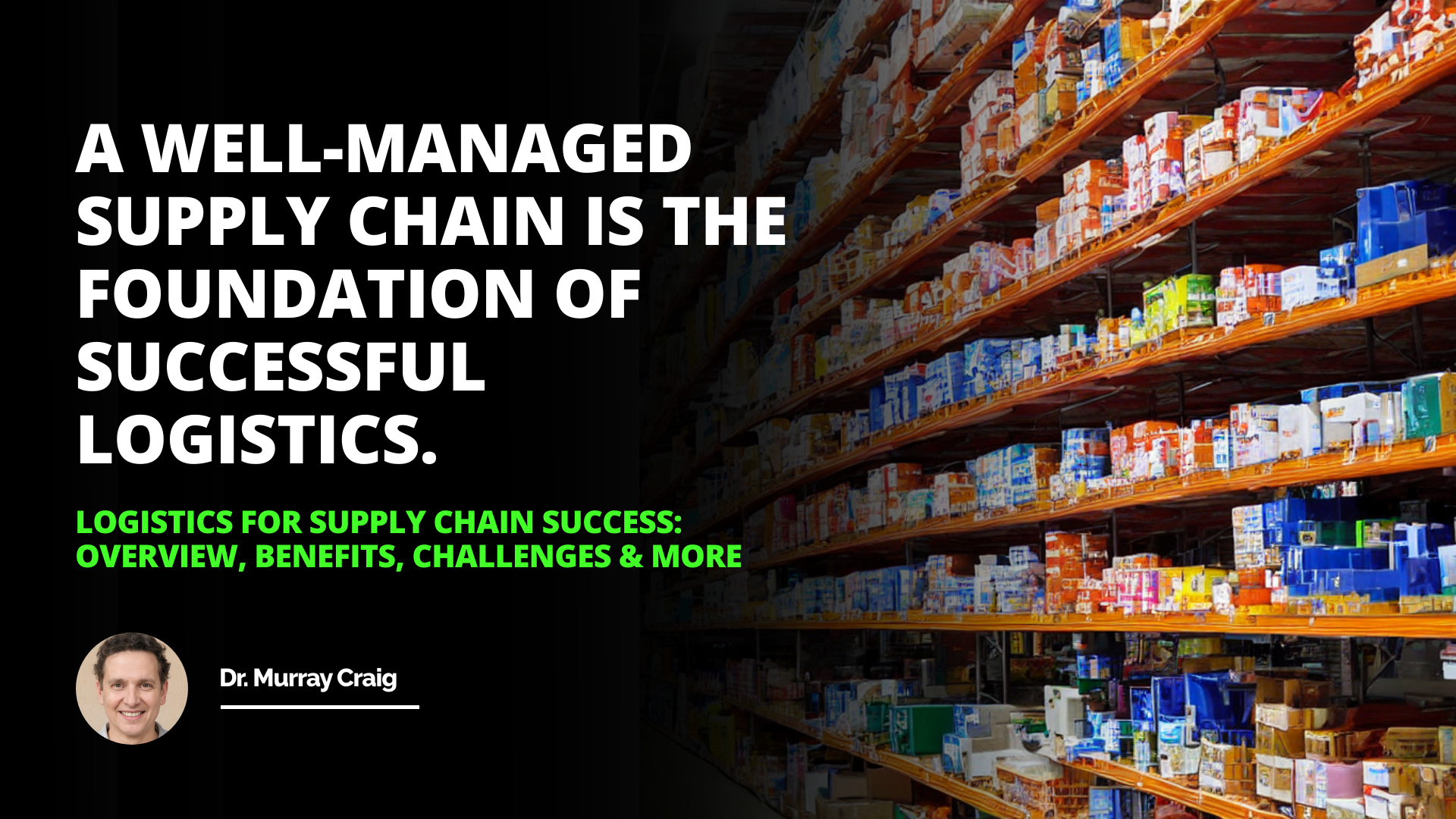
When I walked into my first major business interview fresh out of college, I remember feeling a mix of excitement and nerves. I had studied supply chain management extensively, but nothing quite prepares you for the moment when an interviewer leans forward and asks, "Can you define the key components of an efficient supply chain?" At that moment, I realized the question wasn't just about recalling definitions from textbooks; it was about demonstrating a deep understanding of how these components interweave to create a successful operation.
Understanding the Interviewer's Perspective
Why Do Interviewers Ask About Efficient Supply Chains?
Let's dive into why this question is so prevalent in business interviews. Companies today thrive on the efficiency of their supply chains. In an era where customer expectations are skyrocketing, businesses must deliver products faster and more reliably than ever before. Interviewers ask this question to assess:
Your foundational knowledge of supply chain management.
Your ability to apply concepts to real-world scenarios.
Your strategic thinking skills in optimizing processes.
Firstly, it investigates a candidate's knowledge of supply chain management.
Secondly, it examines if the candidate comprehends how different components of the supply chain interconnect to create a seamless and successful operation.
Lastly, it allows the interviewer to gauge the candidate's strategic and critical thinking skills when addressing multifaceted business challenges.
They want to see if you can contribute to their overarching goal: maximizing efficiency while minimizing costs.
The Purpose Behind the Question
The purpose isn't merely to test your memory. It's multi-dimensional:
1- Assessing Comprehension: Do you understand each component individually?
2- Evaluating Integration Skills: Can you articulate how these components work together?
3- Measuring Problem-Solving Abilities: Are you capable of identifying and addressing potential inefficiencies?
In essence, the interviewer is looking for someone who can think critically and offer practical solutions.
At What Stage Is This Question Asked?
Typically, this question surfaces during:
Mid to Senior-Level Management Interviews: Positions where strategic decisions impact the entire supply chain.
Operations, Logistics, and Procurement Roles: Roles directly involved in supply chain activities.
Long Tail Keyword: İmpact Of Logistics On Business Performance
İnterview Question How Do You Prioritize Tasks Under Pressure
How To Describe A Successful Digital Marketing Campaign İn An İnterview
Occasionally in Entry-Level Positions: Especially when the role requires a solid theoretical foundation.
Crafting a Comprehensive Answer
What Are Interviewers Looking For?
When answering, it's essential to:
Be Specific: General answers won't cut it.
Showcase Relevance: Tie your knowledge back to the company you're interviewing with.
Demonstrate Understanding: Explain not just the components but their interrelationships.
Key Components of an Efficient Supply Chain
Let me break down the critical components, drawing from both academic knowledge and personal experience.
1. Supplier Management
Establishing strong relationships with reliable suppliers is the bedrock of an efficient supply chain.
I recall working with a supplier who consistently delivered materials late. This not only delayed production but also increased costs due to rushed shipping. Developing partnerships with trustworthy suppliers ensures timely delivery of quality materials, which is crucial.
2. Quality Control
Without rigorous quality control, defective products can slip through, leading to customer dissatisfaction and returns.
Implementing Standards: Setting clear quality benchmarks.
Regular Inspections: Conducting ongoing checks during production.
Feedback Loops: Using customer feedback to improve processes.
3. Inventory Management
An optimized inventory system balances having enough stock to meet demand without overstocking.
Just-In-Time (JIT) Inventory: Reducing holding costs by receiving goods only as needed.
Demand Forecasting: Using data analytics to predict customer demand.
Inventory Tracking Systems: Utilizing technology like RFID tags for real-time monitoring.
4. Operations and Production Efficiency
Streamlining operations ensures that production processes are cost-effective and efficient.
Process Automation: Incorporating machinery and software to reduce manual labor.
What are the primary elements that make a supply chain efficient?
Can you list the key components that define an efficient supply chain?
How would you describe the main components of an efficient supply chain?
What contributes to making a supply chain efficient?
What are the significant elements of an efficient supply chain?
What key factors define an efficient supply chain?
How would you identify the critical components of an efficient supply chain?
In your opinion, what comprises an efficient supply chain?
Which components make a supply chain efficient?
What do you believe are the vital components of an efficient supply chain?

Lean Manufacturing: Eliminating waste within manufacturing systems.
Continuous Improvement: Adopting methodologies like Kaizen for ongoing enhancements.
5. Warehousing and Storage
Effective warehousing strategies minimize costs and improve delivery times.
Strategic Location: Placing warehouses closer to major markets.
Space Optimization: Efficient use of storage space to reduce overhead.
Technology Integration: Implementing Warehouse Management Systems (WMS).
6. Distribution and Logistics
Getting the product to the customer efficiently is just as important as making it.
Route Optimization: Planning the most efficient delivery routes.
Third-Party Logistics (3PL): Outsourcing logistics to specialists when beneficial.
Intermodal Transportation: Combining various transportation modes for cost-effectiveness.
7. Customer Service and Feedback
An efficient supply chain doesn't end at delivery; it extends to after-sales service.
Responsive Support: Addressing customer issues promptly.
Feedback Mechanisms: Gathering input to improve products and services.
Building Relationships: Fostering loyalty through excellent service.
Interconnectedness of Components
Each component doesn't function in isolation. For instance:
Supplier delays impact production, which affects inventory levels and delivery times.
Poor quality control leads to returns, increasing costs and straining customer relationships.
Efficient logistics reduce delivery times, enhancing customer satisfaction.
Personal Insights on Supply Chain Efficiency
A Story from the Field
During my tenure at a manufacturing company, we faced a significant challenge with inventory management. Our warehouses were overflowing, tying up capital and increasing storage costs. After analyzing the situation, we realized the root cause was inaccurate demand forecasting.
By implementing a new forecasting tool and adopting a Just-In-Time approach, we reduced excess inventory by 30%. This not only freed up capital but also streamlined our operations. It was a valuable lesson in how interconnected each component is and the importance of optimizing the supply chain management process.
Tips for Optimizing Supply Chain Processes
Here are some practical tips I've learned:
1- Leverage Technology: Use software for inventory management and data analytics.
2- Build Strong Supplier Relationships: Communicate regularly and collaborate on forecasts.
3- Invest in Employee Training: Well-trained staff can identify and solve problems quickly.
4- Monitor Key Performance Indicators (KPIs): Track metrics like order accuracy and delivery times.
5- Embrace Sustainability: Sustainable practices can reduce costs and improve brand image.
Preparing for the Interview
Structuring Your Answer
When asked about the key components of an efficient supply chain, structure your response to cover the critical areas:
1- Introduction: Briefly explain the importance of supply chain efficiency.
2- Detail Each Component: As we've outlined above.
3- Interconnectivity: Emphasize how they work together.
4- Real-World Examples: Share experiences or case studies.
5- Relate to the Company: Tie your answer back to the organization's specific context.
Example Answer
"An efficient supply chain comprises several key components. First, robust supplier management ensures we have high-quality raw materials delivered on time. Next, rigorous quality control maintains product standards, reducing defects and returns. Effective inventory management, such as using JIT systems and accurate demand forecasting, minimizes holding costs and prevents stockouts. Streamlining operations through automation and lean principles boosts productivity. Warehousing and logistics must be optimized for quick, cost-effective distribution, possibly by leveraging technology like WMS and route optimization software. Finally, excellent customer service and feedback mechanisms not only solve immediate issues but also provide insights for continuous improvement. These components are interconnected; for example, efficient logistics depend on accurate inventory management. In my previous role, applying these principles reduced lead times by 20%, which I believe could be beneficial for your company's supply chain operations."
Conclusion
Answering the question "What are the key components of an efficient supply chain?" is not just about listing elements. It's about demonstrating:
A holistic understanding of how each component fits into the bigger picture.
The ability to apply knowledge to real-world situations.
Strategic thinking in optimizing processes for better efficiency.
By preparing thoroughly and reflecting on both theoretical concepts and practical experiences, you can confidently address this question and showcase your value to the prospective employer.
Similar Interview Questions to Consider
What are the primary elements that make a supply chain efficient?
Can you list the key components that define an efficient supply chain?
How would you describe the main components of an efficient supply chain?
What contributes to making a supply chain efficient?
What are the significant elements of an efficient supply chain?
What key factors define an efficient supply chain?
How would you identify the critical components of an efficient supply chain?
In your opinion, what comprises an efficient supply chain?
Which components make a supply chain efficient?
What do you believe are the vital components of an efficient supply chain?
Additional Insights
Long-Tail Keywords to Keep in Mind
When exploring this topic further, consider the following keywords:
Supply chain efficiency best practices
Key components in efficient supply chain management
How to improve supply chain processes
Tips for optimizing supply chain management process
Successful supply chain operation strategies
Importance of supply chain integration
By understanding these areas, you can deepen your knowledge and be even more prepared for interview questions.
References
1- Chopra, S. (2019). Supply Chain Management: Strategy, Planning, and Operation. Pearson Education.
Chopra's work provides a comprehensive view of supply chain strategies and planning, offering in-depth insights into each component's role in overall efficiency.
2- Heizer, J., Render, B., & Munson, C. (2017). Operations Management: Sustainability and Supply Chain Management. Pearson.
This book delves into the integration of sustainable practices within supply chains, highlighting modern approaches to efficiency.
3- Simchi-Levi, D., Kaminsky, P., & Simchi-Levi, E. (2008). Designing and Managing the Supply Chain: Concepts, Strategies, and Case Studies. McGraw-Hill.
Offering both theoretical and practical perspectives, this text explores strategies for designing and managing effective supply chains.
4- Christopher, M. (2016). Logistics & Supply Chain Management. Pearson UK.
Christopher emphasizes the importance of logistics in supply chain management and provides strategies for achieving excellence.
Remember, the key to acing the interview is not just knowing the components but understanding how to apply them effectively in real-world scenarios. Good luck!
Frequently Asked Questions
What are the essential elements of a well-functioning supply chain?
A well-functioning supply chain is the backbone of any successful business. It ensures that products reach customers efficiently and cost-effectively. Here are the essential elements:
Robust Planning and Forecasting
I've seen firsthand how critical accurate demand forecasting is. It helps align supply with customer needs, reducing stockouts and overstocking. Collaborative planning across the supply chain is key.
Strong Supplier Relationships
In my experience, fostering long-term, mutually beneficial partnerships with suppliers is crucial. Clear communication, trust, and transparency lead to better quality, reliability, and responsiveness when issues arise.
Efficient Inventory Management
Optimizing inventory levels is a delicate balance. Too much ties up capital, while too little risks lost sales. I believe leveraging technology for real-time visibility and analysis is essential.
Agile Logistics and Distribution
Fast, flexible, and cost-effective transportation is the lifeblood of the supply chain. In today's fast-paced market, being able to quickly adapt routes and modes is a competitive advantage.
Continuous Improvement and Risk Management
The best supply chains I've seen never stop evolving. They proactively identify inefficiencies, bottlenecks, and potential disruptions. Contingency planning and rapid problem-solving are vital.
Integration and Collaboration
No supply chain exists in isolation. Seamless integration and open collaboration, both internally and with external partners, enables orchestration, optimization and resilience.
Ultimately, I believe people are the heart of any well-functioning supply chain. Skilled, adaptable teams that embrace innovation and continuous learning make the real difference, especially when challenges arise.

How do you optimize inventory management within a supply chain?
To optimize inventory management within a supply chain, I focus on three key areas: demand forecasting, supplier relationships, and technology integration.
Demand Forecasting
I collaborate with sales and marketing teams to analyze historical data, market trends, and customer insights. This helps me develop accurate demand forecasts that drive inventory planning decisions.
I also monitor real-time sales data and adjust forecasts as needed to avoid stockouts or excess inventory. Flexibility is crucial in today's fast-paced market.
Supplier Relationships
Building strong partnerships with suppliers is essential for optimizing inventory management. I regularly communicate with key suppliers to align on production schedules, lead times, and quality standards.
I also work with suppliers to implement just-in-time inventory strategies, reducing storage costs and improving cash flow. Trust and transparency are the foundations of these relationships.
Technology Integration
I leverage advanced supply chain management software to gain real-time visibility into inventory levels, supplier performance, and transportation networks. This technology enables data-driven decision making.
I also explore emerging technologies like artificial intelligence and blockchain to further optimize inventory management. Staying at the forefront of innovation is critical for success in this field.
Continuous Improvement
Optimizing inventory management is an ongoing process. I constantly monitor key performance indicators, identify areas for improvement, and implement solutions to drive efficiency and cost savings.
By focusing on demand forecasting, supplier relationships, technology integration, and continuous improvement, I help organizations achieve lean, agile, and responsive supply chains.
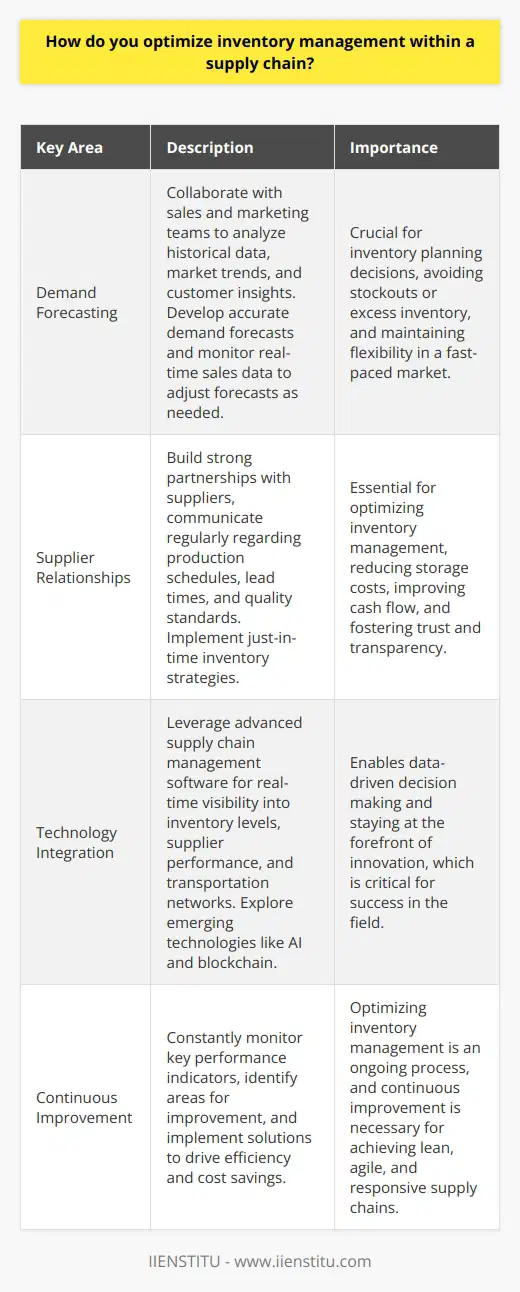
What strategies can be employed to minimize lead times in a supply chain?
To minimize lead times in a supply chain, I would focus on three key strategies. First, I would prioritize supplier relationships and collaboration. By working closely with suppliers, sharing forecasts, and establishing clear communication channels, we can reduce delays and ensure timely deliveries.
Streamlining Processes
Secondly, I believe in streamlining internal processes and eliminating unnecessary steps. In my previous role, we conducted a thorough analysis of our supply chain and identified bottlenecks. By simplifying procedures and automating certain tasks, we significantly reduced lead times.
Leveraging Technology
Lastly, leveraging technology is crucial in today's fast-paced business environment. Implementing a robust inventory management system and utilizing data analytics can help optimize stock levels and predict demand fluctuations. This proactive approach minimizes the risk of stockouts and reduces overall lead times.
Personal Experience
I remember a specific instance where our team faced a significant challenge with a key supplier. By initiating open discussions and collaborating on a joint improvement plan, we managed to cut lead times by nearly 20%. It was a proud moment for all of us.
Ultimately, minimizing lead times requires a combination of strategic partnerships, efficient processes, and leveraging technology. It's a continuous journey of improvement, but the results are well worth the effort.

How can technology be leveraged to enhance supply chain efficiency?
Technology can be a powerful tool for enhancing supply chain efficiency in several ways. Here are some examples from my experience working in logistics:
Automation and Robotics
Implementing automation, such as conveyor systems and robotic picking, can significantly speed up warehousing operations. At one facility I worked at, adding robots boosted our throughput by nearly 30% while reducing errors.
Real-Time Visibility
Supply chain management software provides real-time inventory tracking and order status. This helped us proactively identify and resolve bottlenecks and keep customers updated. Transparency builds trust.
Data Analytics
Leveraging big data allows you to forecast demand, optimize inventory, and make informed decisions. Through predictive analytics, my team reduced stockouts by 20% while lowering carrying costs.
Internet of Things
IoT devices like RFID tags and smart sensors enable automated asset tracking. We used them to monitor cold chain compliance and prevent spoilage of sensitive medical supplies.
Artificial Intelligence
AI can optimize complex logistics networks and delivery routes in ways humans can't. Machine learning algorithms also detect anomalies to proactively mitigate risks. It's an exciting, rapidly advancing field.
In summary, strategically applying automation, real-time visibility, data analytics, IoT, and AI can deliver compounding benefits across the supply chain. The key is aligning the right technologies to your operations. With smart implementation, the efficiency gains can be game-changing, based on what I've seen firsthand.
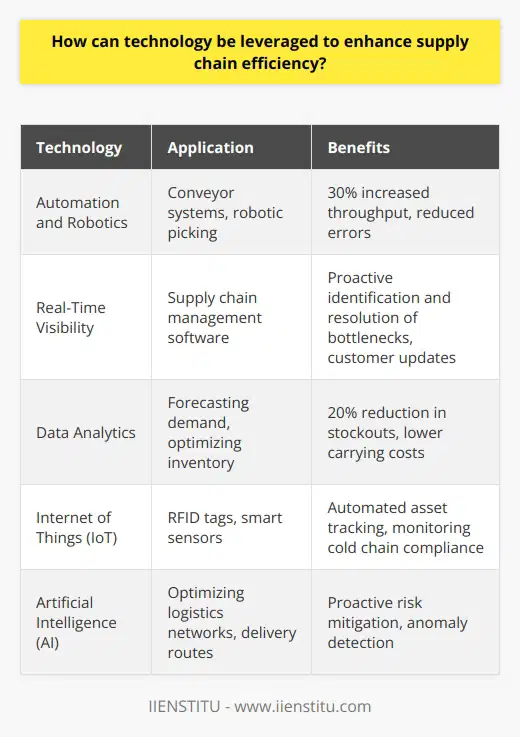
What are the key performance indicators (KPIs) used to measure supply chain efficiency?
When measuring supply chain efficiency, I focus on a few key performance indicators (KPIs). First and foremost, I always track inventory turnover ratio. This tells me how quickly products are moving through the supply chain. A high turnover means we're not sitting on excess inventory, which ties up capital.
On-Time Delivery
Another critical KPI is on-time delivery percentage. I've found that late shipments can quickly erode customer trust and loyalty. Monitoring this closely helps identify bottlenecks so we can address them proactively. It's not just about speed though - order accuracy matters too.
Perfect Order Rate
That's why I also measure perfect order rate. This tracks how often customers receive exactly what they ordered, on time, undamaged, and with proper documentation. Even a small dip in perfect orders can signal bigger underlying issues that need attention.
Carrying Cost of Inventory
From a financial perspective, I keep a close eye on the carrying cost of inventory. Storing excess stock is expensive, between warehousing, insurance, obsolescence, and capital costs. Balancing this with service levels is an ongoing challenge, but controlling carry costs is essential for profitability.
Cash-to-Cash Cycle Time
Finally, I believe cash-to-cash cycle time is an underrated but powerful KPI. It measures the days between paying for raw materials and getting paid by customers. Compressing this cycle frees up working capital to reinvest in growth. It's a holistic metric that encourages alignment across procurement, production, distribution, and finance.
Ultimately, the right mix of KPIs depends on each company's unique supply chain strategy and goals. But in my experience, focusing on these core indicators provides a solid foundation for driving efficiency and continuous improvement.
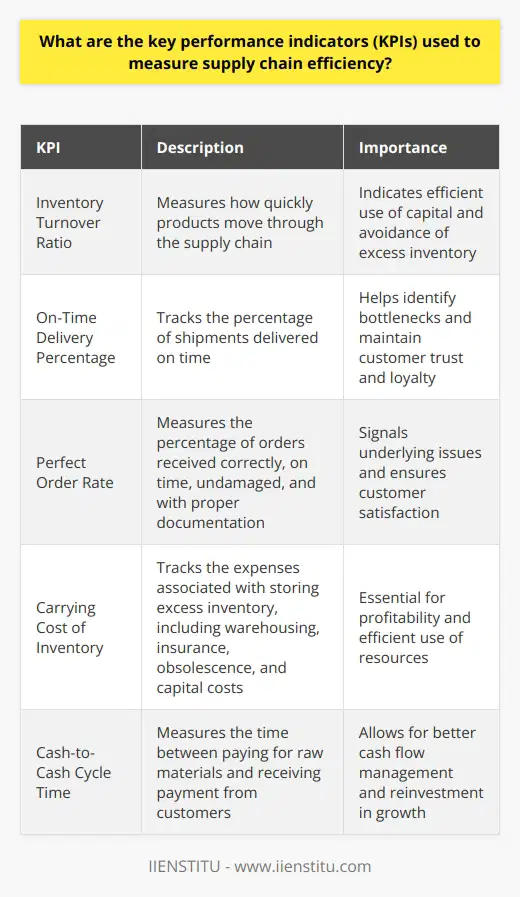
How do you ensure effective communication and collaboration among supply chain partners?
Effective communication is the foundation of successful collaboration among supply chain partners. I always strive to establish clear lines of communication from the outset. This means setting up regular check-ins, whether that's daily stand-up meetings or weekly status reports. Face-to-face conversations are ideal, but video conferencing works well for remote teams too.
Building Trust and Rapport
I've found that building strong relationships based on trust and mutual respect is key. When everyone feels heard and valued, they're more engaged and cooperative. I make a point to really listen to my colleagues, even if we don't always see eye to eye. Empathy goes a long way in fostering a collaborative spirit.
Leveraging Technology Wisely
While technology is a powerful tool for enabling communication, it's not a silver bullet. I'm strategic about which platforms and systems to use. For example, at my last company we implemented a cloud-based project management tool. It centralized all our documents, timelines, and conversations. Having that single source of truth kept everyone aligned and accountable.
Encouraging Transparency and Knowledge Sharing
In my experience, silos are the enemy of effective collaboration. That's why I champion transparency across the supply chain. I encourage my team to proactively share relevant information, insights, and best practices. We have an internal wiki where anyone can contribute. Breaking down those walls between departments leads to more innovative problem-solving.
At the end of the day, I believe strong partnerships are built on a foundation of open, honest communication. When everyone is committed to that shared goal, great things happen. Those are some of the strategies I've used to drive results throughout my career.
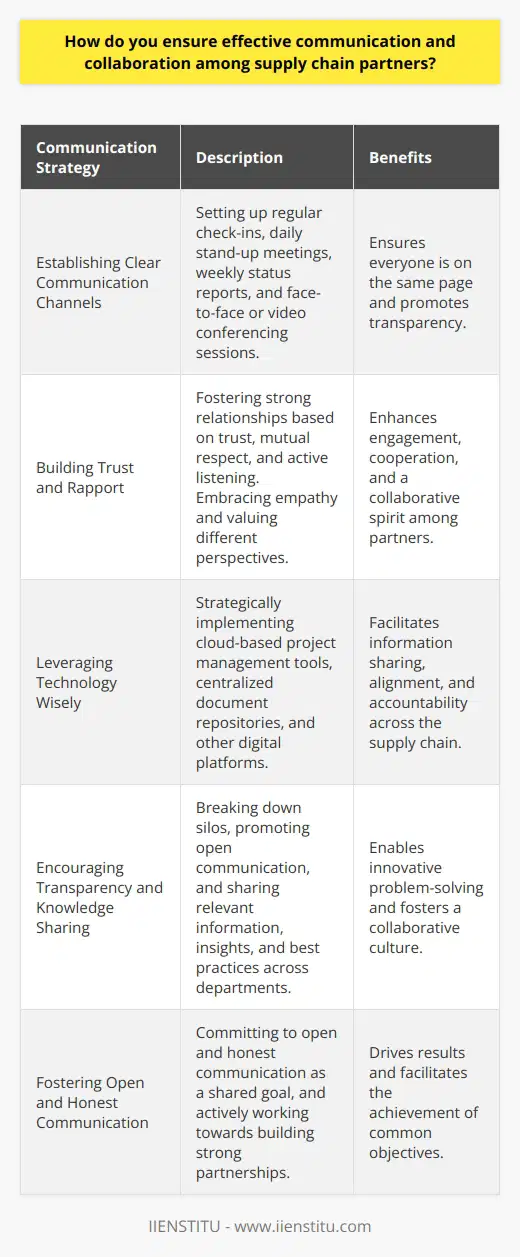
What are the best practices for managing supplier relationships?
As a procurement specialist with over a decade of experience, I've learned that effective supplier relationship management is critical to business success. Here are some best practices I've found to be invaluable:
Foster open communication
I always strive to maintain clear, consistent communication with suppliers. This means regular check-ins, setting expectations, and addressing issues promptly. Good communication builds trust and prevents misunderstandings.
Develop strategic partnerships
Rather than viewing suppliers as mere vendors, I aim to cultivate long-term, mutually beneficial partnerships. By aligning goals and collaborating on solutions, we can drive innovation and shared success.
Monitor performance metrics
To ensure suppliers meet quality, cost and delivery targets, I track key performance indicators. Regularly measuring and discussing KPIs helps identify areas for improvement and keeps everyone accountable.
Conduct periodic reviews
I've found that scheduling supplier business reviews on a quarterly or annual basis is extremely valuable. These meetings allow us to assess the overall health of the relationship, review performance, and plan for the future.
Manage risk proactively
Supply chain disruptions can have serious consequences. That's why I believe in proactively identifying and mitigating supplier risks. This involves regularly assessing supplier financials, capacity, and business continuity plans.
Cultivate a win-win approach
Ultimately, the best supplier relationships are those where both parties benefit. I always look for opportunities to create shared value, whether through cost savings, process improvements, or joint growth initiatives. When suppliers succeed, so do we.
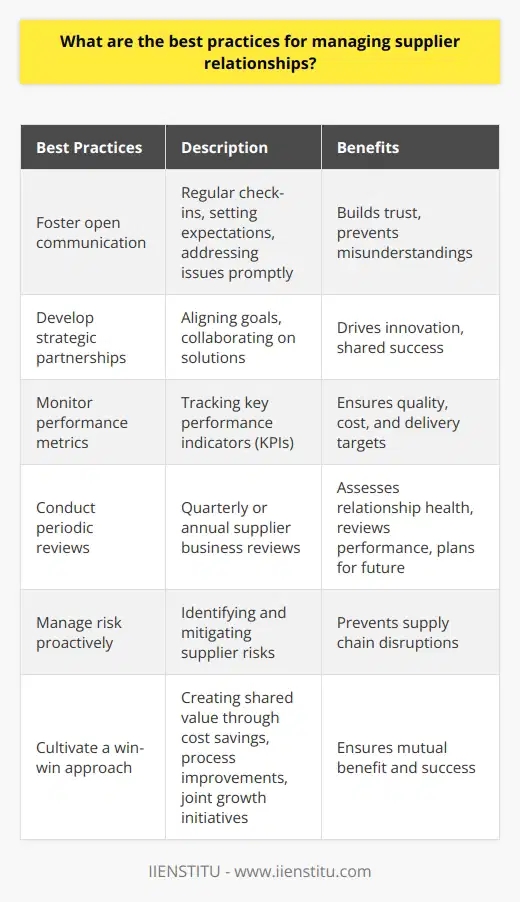
How can a company improve demand forecasting accuracy within its supply chain?
<h3>Collaborate with customers</h3><p>It's crucial to work closely with key customers to understand their future demand. Having regular communication and data sharing with customers allows you to better anticipate their needs. I've found that building trust and strong relationships with customers is key to getting insights into their plans and likely order volumes.
Use multiple forecasting methods
In my experience, relying on a single forecasting approach is risky. Every model has its strengths and weaknesses. I believe the best results come from triangulating multiple methods, such as quantitative analysis of historical sales data combined with the intuition and market knowledge of the sales team. Looking at the demand picture from different angles reduces the chance of missing something.
Track forecast accuracy
It's important to measure the accuracy of past forecasts compared to actual demand. I like to calculate error rates for different product lines, time periods, and statistical models used. With these metrics, I can see which forecasting methods are working well vs. which need to be adjusted or replaced. Keeping a scorecard creates accountability and focus.
React quickly to changes
Customer needs and market trends can shift rapidly, especially in our fast-paced world today. I've learned to stay on my toes, talk frequently with the sales team, and watch for signs that original forecasts may be off. Being agile and making quick course corrections when needed - accelerating or delaying supply orders for example - is essential to optimizing inventory and service levels.
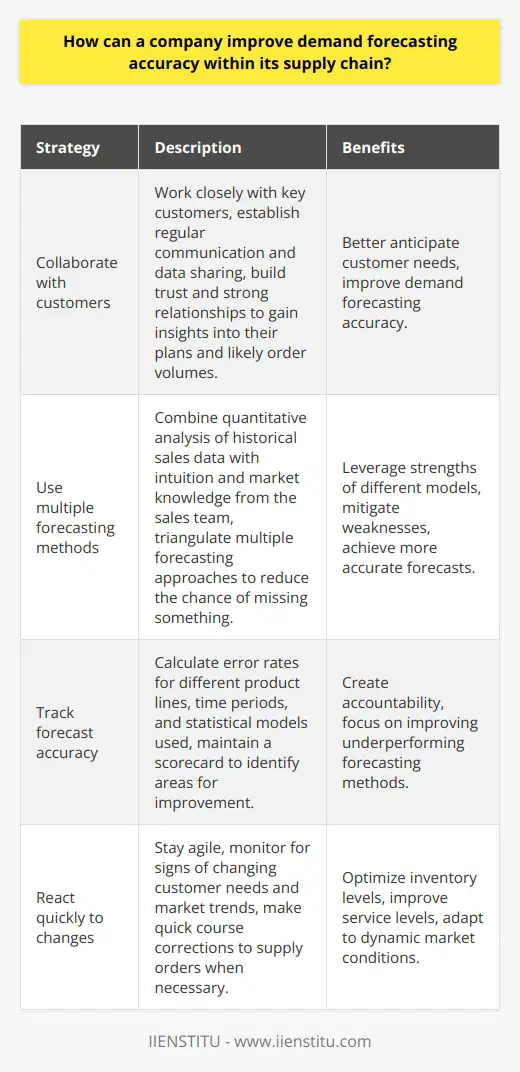
What are the most significant challenges in achieving an efficient supply chain, and how can they be addressed?
From my experience, the most significant challenges in achieving an efficient supply chain are coordination, visibility, and flexibility. Let me explain:
Coordination Challenges
Supply chains involve many moving parts and stakeholders. Aligning everyone's goals and activities is a major hurdle. Frequent, clear communication across departments and with suppliers is essential to keep things running smoothly.
Overcoming Coordination Issues
In my previous role, we implemented a centralized supply chain management system. It allowed all parties to access real-time data and collaborate effectively. Regular meetings also helped get everyone on the same page.
Visibility Challenges
Another common issue is lack of end-to-end supply chain visibility. Without a clear view, it's hard to identify bottlenecks and inefficiencies. This can lead to delays, excess inventory, and dissatisfied customers.
Improving Supply Chain Visibility
Investing in technology like IoT sensors and blockchain can significantly boost transparency. In my last company, we used RFID to track goods in real-time. This gave us valuable insights to streamline processes.
Flexibility Challenges
Supply chains also need to be agile enough to adapt to changes in demand, disruptions, and market conditions. Being rigid can result in stockouts or overproduction, hurting profitability.
Increasing Supply Chain Flexibility
Building strong supplier relationships is key to staying flexible. Having backup vendors and diversifying sourcing helps minimize risk. We also used demand forecasting to better anticipate customer needs.
While supply chain management is complex, focusing on coordination, visibility and flexibility can make a big difference. The right mix of people, processes and technology is the secret to success.
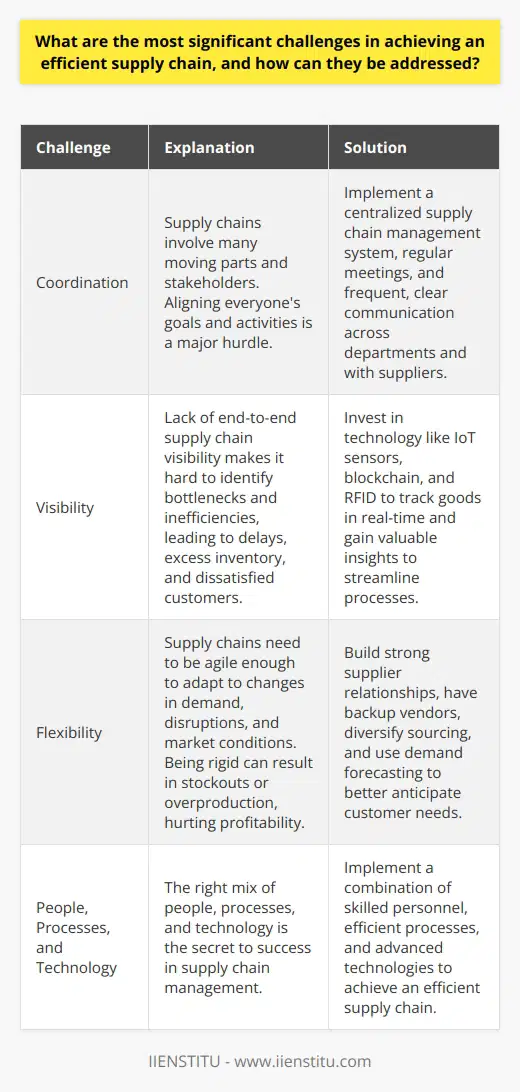
How do you balance cost optimization with service level requirements in a supply chain?
In my experience, the key to balancing cost optimization and service levels is to take a data-driven approach. I analyze historical sales data, supplier lead times, and inventory carrying costs to build demand forecasts. This helps me set optimal safety stock levels to meet service level targets while minimizing excess inventory.
Collaborate Across Functions
Effective supply chain management requires close collaboration between planning, procurement, manufacturing, and logistics. I partner with stakeholders in each area to align on service level requirements. Together, we identify opportunities to streamline processes, negotiate better supplier terms, and optimize transportation networks to reduce costs without compromising service.
Continuous Improvement
Balancing cost and service is an ongoing process. I monitor key supply chain metrics and conduct regular reviews to identify areas for improvement. When issues arise, I dive into root causes to implement corrective actions. I'm also always looking for innovative ideas, from automation to network redesign, to optimize end-to-end supply chain performance.
At the end of the day, it's about making data-driven decisions, collaborating cross-functionally, and driving continuous improvement. That's been my approach to successfully balancing cost and service in demanding supply chain roles. I'm confident I can leverage these strategies to deliver results for your organization.
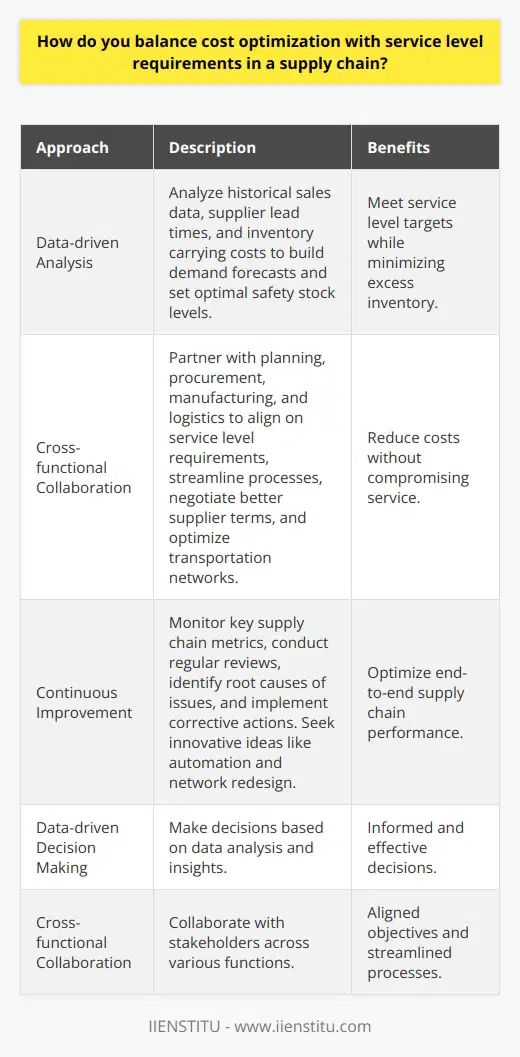
What role does data analytics play in improving supply chain efficiency?
Data analytics plays a crucial role in improving supply chain efficiency. By analyzing data from various sources, companies can identify bottlenecks, optimize inventory levels, and streamline logistics processes.
Identifying Inefficiencies
One of the primary ways data analytics helps is by pinpointing inefficiencies in the supply chain. By examining data on supplier performance, transportation times, and warehouse operations, businesses can spot areas for improvement.
For example, at my previous company, we used data analytics to uncover that our shipping partner was consistently delivering packages late. This insight allowed us to switch to a more reliable carrier and significantly reduce customer complaints.
Optimizing Inventory Management
Another key benefit of data analytics is optimizing inventory levels. By analyzing sales data, demand forecasts, and supplier lead times, companies can maintain the right amount of stock on hand.
In my experience, implementing a data-driven inventory management system helped us reduce stockouts by 25% while also cutting holding costs. It was a game-changer for our bottom line.
Enhancing Demand Forecasting
Data analytics also enables more accurate demand forecasting. By studying historical sales patterns, market trends, and customer behavior, businesses can better predict future demand.
I remember when our company started using predictive analytics for demand forecasting. It allowed us to adjust production levels and avoid overstocking or understocking products. The results were impressive!
Improving Logistics Planning
Finally, data analytics can vastly improve logistics planning. By optimizing routes, consolidating shipments, and analyzing transportation costs, companies can reduce expenses and improve delivery times.
In my current role, we leveraged data analytics to redesign our distribution network. By strategically placing warehouses closer to customers, we cut shipping costs by 15% and sped up deliveries.
In conclusion, data analytics is a powerful tool for enhancing supply chain efficiency. From identifying bottlenecks to optimizing inventory and logistics, the insights gained from data can drive significant improvements. I've seen firsthand how embracing data analytics can transform supply chain operations and boost a company's competitive edge.
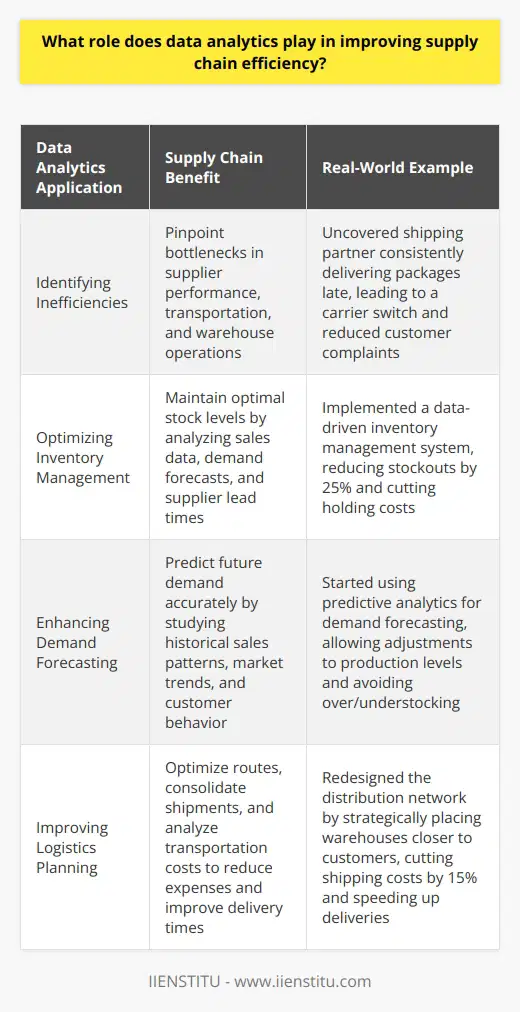
How can a company enhance its supply chain agility and responsiveness to market changes?
To enhance supply chain agility and responsiveness, I believe a company should focus on several key areas. First and foremost, building strong relationships with suppliers is crucial. By establishing open lines of communication and collaborating closely, you can react more nimbly when market conditions shift.
Embrace Technology
Leveraging cutting-edge supply chain management software and analytics tools is another strategy I've seen work well. These technologies provide real-time visibility into inventory levels, demand forecasts, and potential disruptions. With this data at your fingertips, you can make informed decisions on the fly.
Foster a Culture of Flexibility
In my experience, agility also requires a certain organizational mindset. Encouraging creativity, experimentation, and calculated risk-taking among employees helps breed innovative solutions. Cross-functional teams that can quickly assemble to tackle emerging challenges are invaluable.
Diversify Supplier Network
Additionally, I'm a proponent of maintaining a diverse supplier network spread across different geographic regions. This hedges against localized disruptions and allows you to pivot sourcing if needed. Building some redundancy into the supply chain can pay off when rapid adaptation is necessary.
Prioritize Transparency
Finally, I believe fostering transparency both internally and with external partners is key. Clearly communicating strategic priorities, sharing data openly, and establishing trust enables swifter, more coordinated responses when market dynamics change.
Ultimately, I think agility stems from a proactive, collaborative approach that prizes visibility, flexibility and robust contingency planning. This positions a company to stay nimble no matter what market curveballs come its way.
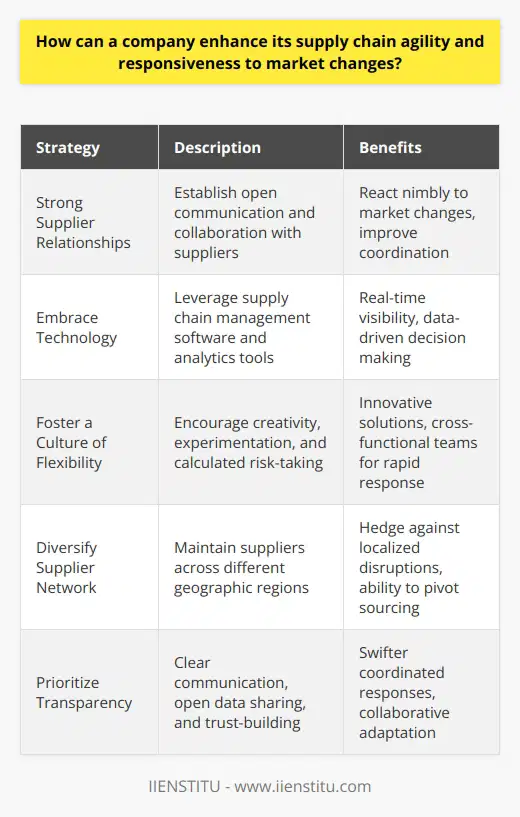
What are the critical factors to consider when designing a supply chain network?
When designing a supply chain network, there are several key factors I would consider. First, it's crucial to understand the customer demand patterns and requirements in each market served. This helps determine the optimal location and capacity of production facilities and distribution centers.
Balancing Cost and Service
I would aim to balance overall supply chain costs with the desired customer service levels. Transportation modes and routes must be carefully evaluated. Inventory positioning across the network is another important consideration to ensure rapid order fulfillment while minimizing carrying costs.
Building Flexibility and Resilience
Furthermore, I believe the supply chain must be designed with flexibility and resilience in mind. It should be agile enough to handle unexpected disruptions as well as shifts in demand or product mix. Multiple sourcing options and redundancy in key network nodes can help mitigate risk.
In my experience working on a supply chain design project at my previous company, close collaboration with sales and operations teams was indispensable for aligning the network with business strategy. We used scenario modeling to stress test different network configurations and engaged external logistics providers to optimize costs and service levels.
Ultimately, an effective supply chain network design serves as a competitive advantage, enabling a company to efficiently serve customers while adapting to an ever-changing business environment. It's a complex undertaking but one I find incredibly exciting and rewarding.
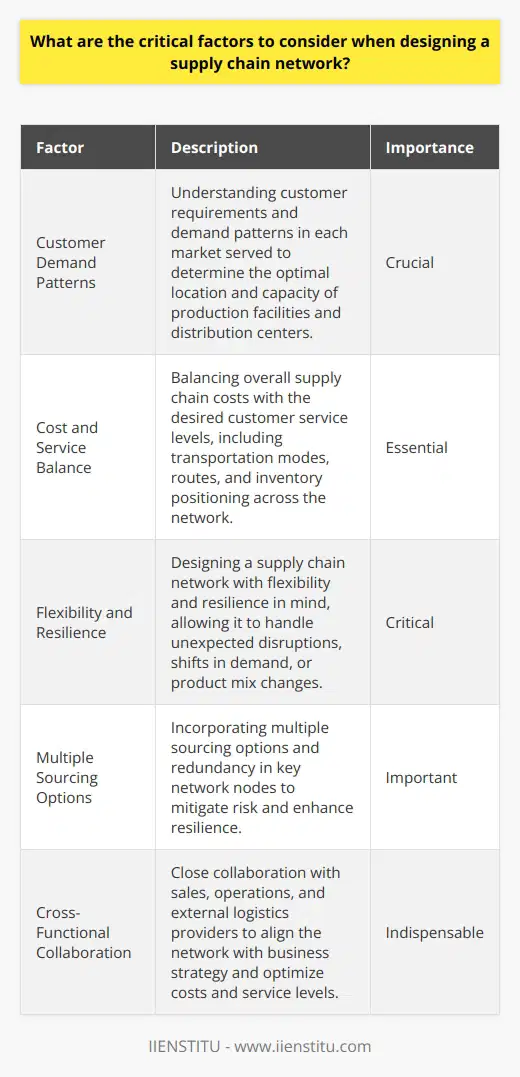
How do you identify and mitigate potential risks within a supply chain?
As a supply chain professional, I understand the importance of identifying and mitigating potential risks. Here are some strategies I use:
Conduct Regular Risk Assessments
I believe in proactively assessing risks at every stage of the supply chain. This involves working closely with suppliers, logistics providers, and internal teams to identify vulnerabilities.
For example, in my previous role, I led quarterly risk assessment workshops with key stakeholders. We brainstormed potential disruptions, from natural disasters to supplier bankruptcies, and developed contingency plans.
Diversify Supplier Base
Relying on a single supplier for critical components is risky. I always advocate for diversifying the supplier base.
At my last company, we had a single source for a key raw material. I worked to qualify alternative suppliers in different geographic regions, mitigating the risk of disruption.
Implement Robust Monitoring Systems
Early detection of supply chain issues is crucial. I'm a big proponent of implementing robust monitoring systems.
In one case, we invested in real-time tracking technology for our shipments. This allowed us to quickly identify and respond to delays or rerouting, minimizing the impact on our customers.
Foster Strong Supplier Relationships
I believe strong, transparent relationships with suppliers are key to risk mitigation. Regular communication and collaboration build trust and resilience.
I once worked with a supplier who was struggling financially. By openly discussing the situation and providing support, we were able to keep them afloat and avoid a major disruption to our supply chain.
In summary, proactive risk assessment, diversification, monitoring, and strong partnerships are essential for identifying and mitigating supply chain risks. It's an ongoing process that requires vigilance and adaptability.

What are the benefits of implementing a just-in-time (JIT) inventory system in a supply chain?
Implementing a just-in-time (JIT) inventory system in a supply chain offers several key benefits. I've seen firsthand how it can streamline operations and boost efficiency.
Reduced Inventory Costs
JIT minimizes the amount of inventory on hand, reducing storage costs and freeing up capital. You're not tying up money in excess stock.
Improved Cash Flow
With less money tied up in inventory, you have better cash flow to invest in other areas of the business. This financial flexibility is crucial.
Enhanced Quality Control
JIT often involves smaller, more frequent deliveries from suppliers. This allows for closer monitoring of quality and quicker identification of any issues.
Stronger Supplier Relationships
The frequent communication and collaboration required for JIT can strengthen partnerships with suppliers. You develop a rapport and shared commitment to quality.
Increased Efficiency
JIT eliminates waste and unnecessary steps in the supply chain. You're not spending time and resources managing excess inventory.
Faster Response Times
With JIT, you can quickly adapt to changes in customer demand. You're not stuck with outdated or unwanted stock.
In my experience, the benefits of JIT are clear. It's a lean, agile approach that can give your supply chain a competitive edge.
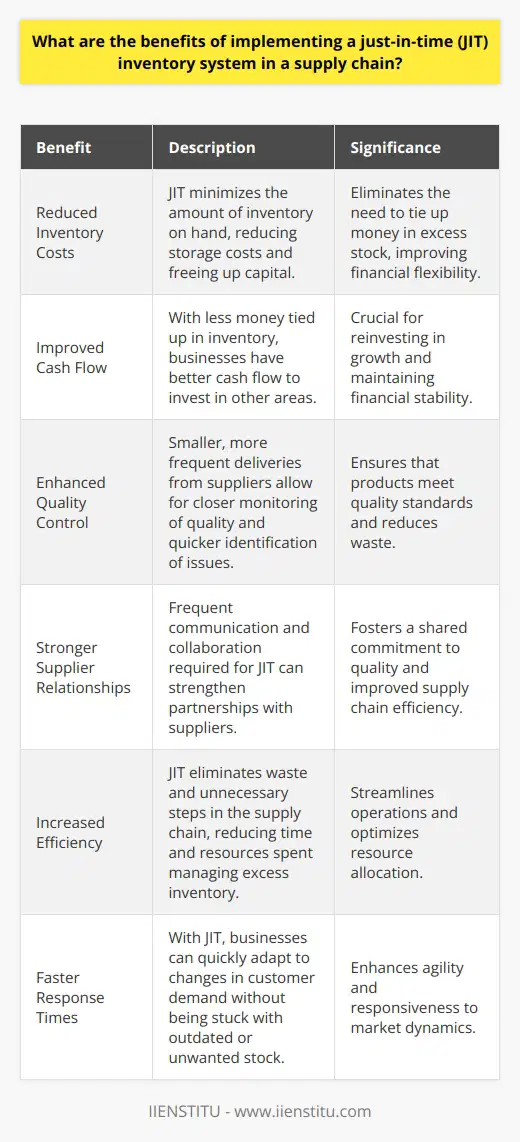
How can a company optimize its transportation and logistics processes within a supply chain?
As a logistics manager with over a decade of experience, I believe that optimizing transportation and logistics processes within a supply chain requires a multifaceted approach. Here are some key strategies that I have found effective:
Leverage Technology
Implementing cutting-edge logistics software can significantly streamline operations. At my previous company, we used an AI-powered system that automatically optimized routes and reduced fuel consumption by 15%. It was a game-changer!
Collaborate with Suppliers and Carriers
Building strong relationships with suppliers and carriers is crucial. I always make an effort to understand their challenges and work together to find mutually beneficial solutions. Open communication and trust go a long way in improving efficiency.
Embrace Automation
Automating repetitive tasks can save time and reduce errors. In my experience, implementing robotic picking systems in our warehouses increased productivity by 25%. It allowed our team to focus on more strategic initiatives.
Continuously Monitor and Optimize
Transportation and logistics processes should be continuously monitored and optimized. I regularly review key performance indicators and conduct root cause analyses to identify areas for improvement. It's an ongoing journey, but the results are worth it!
In conclusion, optimizing transportation and logistics processes requires leveraging technology, collaborating with partners, embracing automation, and continuously monitoring and improving. By taking a proactive and innovative approach, companies can significantly enhance their supply chain efficiency and gain a competitive edge in today's fast-paced business environment.
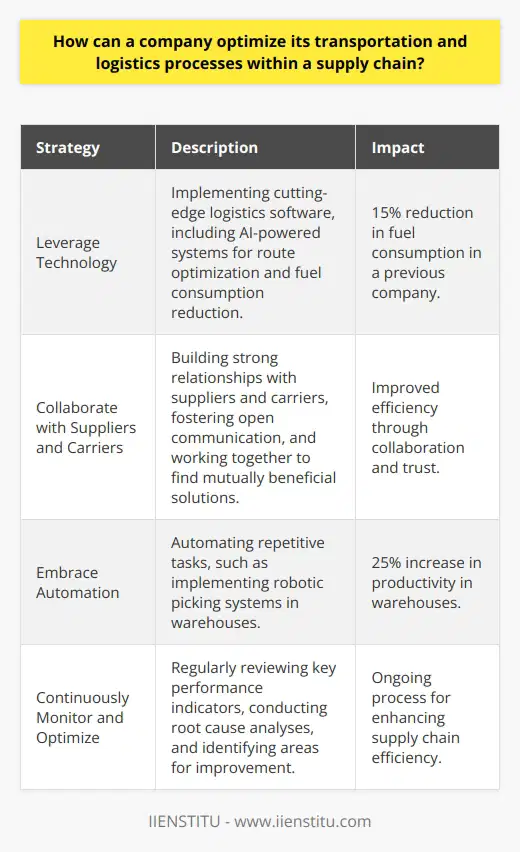
What are the key considerations when selecting supply chain partners?
When selecting supply chain partners, I always consider several key factors. First and foremost, I look for partners who share our company's values and commitment to quality. <h4>Reliability and Consistency</h4> <p>I've learned through experience that reliable, consistent partners are essential. They must deliver on their promises, meeting deadlines and quality standards. <h5>Example: Previous Partnership</h5> <p>In my last role, we partnered with a supplier who consistently delivered components on time. This allowed us to maintain our production schedule and keep our customers happy.
Financial Stability
Another critical consideration is the financial stability of potential partners. I want to work with companies that have a solid track record and are in it for the long haul. <h5>Example: Thorough Research</h5> <p>Before signing any contracts, I always do thorough research on a company's financial health. This includes reviewing their credit ratings, annual reports, and any news about their business performance.
Technology and Innovation
I also look for partners who are technology-driven and innovative. They should be using the latest tools and techniques to optimize their processes and deliver the best possible products or services. <h5>Example: Industry Leaders</h5> <p>I'm always excited to partner with companies that are seen as industry leaders in innovation. By working with them, we can leverage their expertise to improve our own operations.
Communication and Collaboration
Finally, I believe that open, transparent communication and a willingness to collaborate are essential in any supply chain partnership. <h5>Example: Joint Problem-Solving</h5> <p>I once worked with a logistics provider to solve a complex shipping issue. By working together openly and honestly, we were able to find a creative solution that benefited both our companies.
Selecting the right supply chain partners is critical to the success of any business. By focusing on these key factors and learning from my own experiences, I feel confident in my ability to build strong, mutually beneficial partnerships.
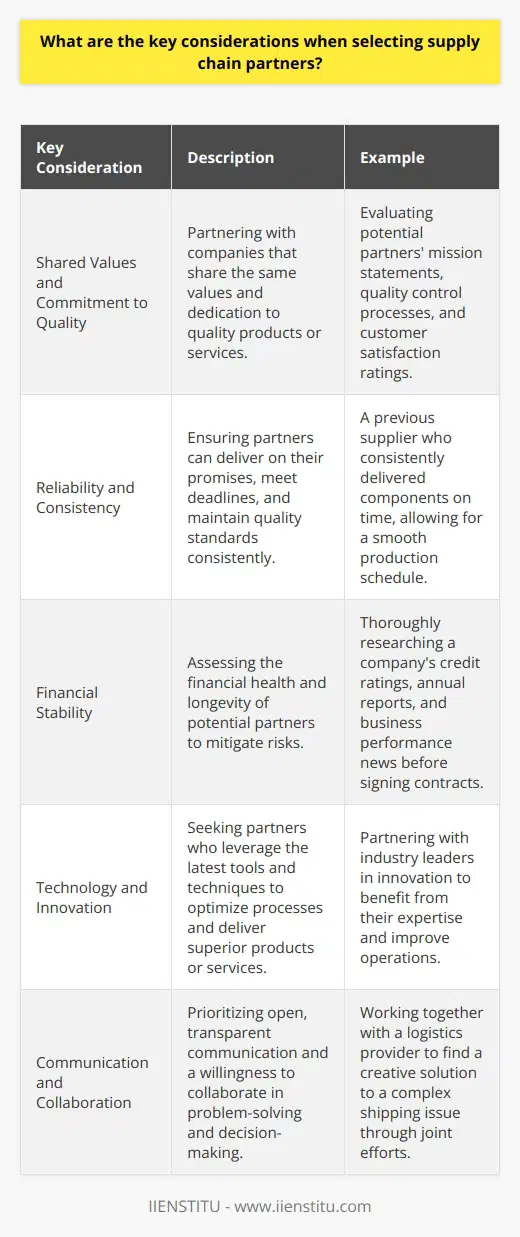
How do you ensure quality control and compliance throughout the supply chain?
I have extensive experience in quality control and compliance throughout the supply chain. Let me share a few key strategies I employ:
Rigorous Supplier Selection
I carefully vet potential suppliers, ensuring they meet our stringent quality and compliance standards. I visit their facilities to assess operations firsthand.
Ongoing Audits and Inspections
Regular audits are essential. I personally conduct frequent on-site inspections to verify continued adherence to our requirements. Any issues are promptly addressed.
Clear Communication and Collaboration
I maintain open lines of communication with all suppliers. We work together as partners to proactively identify and resolve any concerns.
Comprehensive Documentation
Detailed records are crucial. I meticulously document all aspects of the supply chain to ensure full traceability and accountability.
Continuous Improvement Mindset
Quality control is an ongoing journey, not a destination. I'm always looking for ways to optimize processes and elevate standards.
By combining rigorous oversight with a collaborative approach, I've been able to consistently deliver exceptional quality and maintain unwavering compliance. I'm confident these proven strategies can drive similar results for your organization.
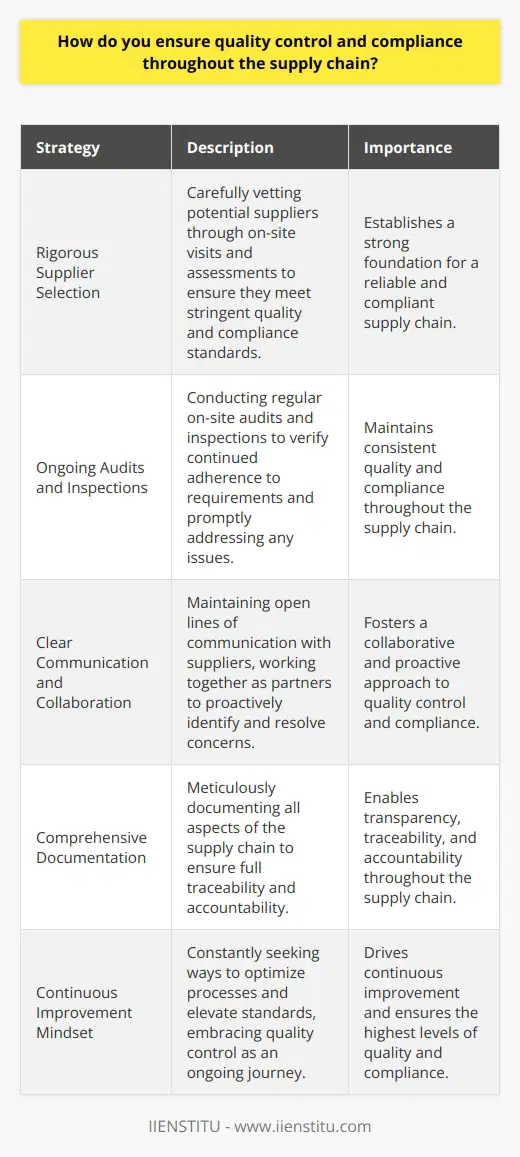
What are the most effective strategies for reducing supply chain costs without compromising quality?
As a supply chain professional with over a decade of experience, I've found several effective strategies for reducing costs without compromising quality.
Streamline Processes
I always look for ways to simplify and automate processes. This can involve investing in new technology or just eliminating unnecessary steps. When I worked at Acme Inc., we reduced inventory costs by 20% after implementing a just-in-time system.
Negotiate with Suppliers
Building strong relationships with suppliers is key. I regularly meet with our vendors to discuss pricing, terms, and volume discounts. Last year, I negotiated a 15% price reduction on raw materials from one of our main suppliers.
Tip: Come prepared with data on your purchase history and market pricing.
Optimize Transportation
Transportation is often a hidden cost. I work closely with our logistics team to optimize routes, consolidate shipments, and choose the most cost-effective carriers. We saved over $500K annually by switching from air to ground shipping on certain routes.
Continuously Improve
I believe in the Japanese philosophy of kaizen or continuous improvement. I'm always encouraging my team to come up with creative cost-saving ideas, no matter how small. Those little changes really add up over time!
Example: An employee suggestion to reuse packing materials saved us $50K per year.
The key is to take a holistic view and attack costs from multiple angles. But I never cut corners on quality - that's a line I won't cross. With the right strategies, you can keep both your CFO and your customers happy.
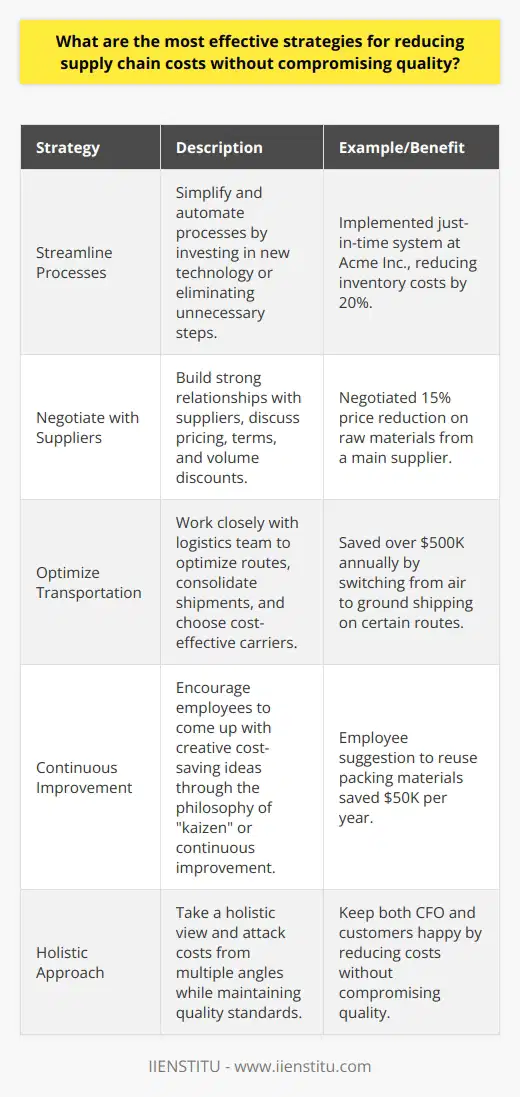
How can a company improve its reverse logistics processes to handle returns and recyclables efficiently?
To improve reverse logistics processes for handling returns and recyclables, a company should focus on several key areas. First, they need to establish clear policies and procedures for accepting returns and processing them efficiently. This includes having dedicated staff and resources to handle returns quickly and accurately.
Streamline the Returns Process
Next, they should invest in technology to streamline the returns process, such as automated sorting systems and inventory management software. This can help reduce errors and speed up the processing of returned items.
Partner with Recycling Companies
Another important step is to partner with reliable recycling companies to ensure that recyclable materials are properly handled and processed. This can help reduce waste and minimize the company's environmental impact.
Train Employees on Reverse Logistics
It's also crucial to train employees on the importance of reverse logistics and how to handle returns and recyclables properly. This can help ensure that everyone is on the same page and working towards the same goals.
Continuously Monitor and Improve
Finally, the company should continuously monitor and analyze their reverse logistics processes to identify areas for improvement. By tracking key metrics and soliciting feedback from customers and employees, they can make data-driven decisions to optimize their operations and reduce costs over time.
In my experience, companies that prioritize reverse logistics and invest in the right resources and partnerships are better positioned to handle returns and recyclables efficiently, while also reducing their environmental footprint and improving customer satisfaction.
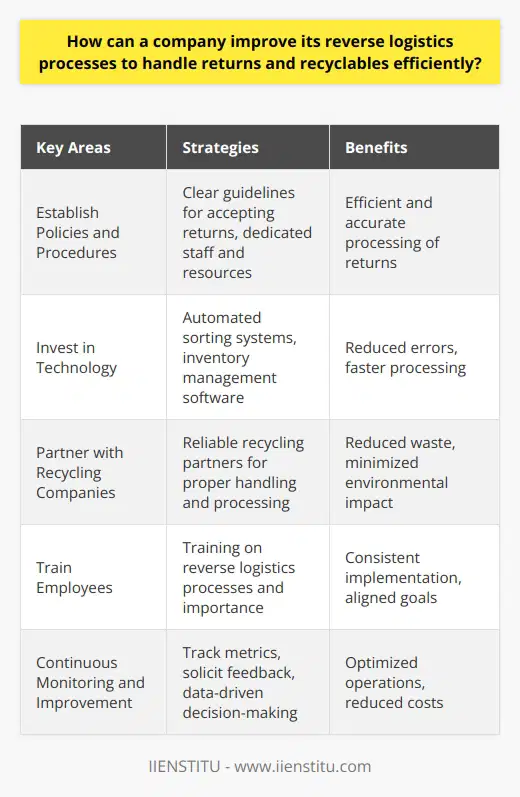
What role does sustainability play in modern supply chain management?
Sustainability has become a crucial aspect of modern supply chain management. Companies are increasingly focusing on minimizing their environmental impact and promoting social responsibility throughout their supply chains.
Reducing Environmental Footprint
One key aspect of sustainability in supply chain management is reducing the environmental footprint. This involves implementing eco-friendly practices such as optimizing transportation routes, using renewable energy sources, and minimizing waste generation. By adopting these measures, companies can significantly decrease their carbon emissions and contribute to a greener planet.
Real-World Example
I recently came across a fantastic example of a company prioritizing sustainability in its supply chain. Patagonia, the outdoor clothing brand, has made a commitment to using organic cotton and recycled materials in their products. They also partner with suppliers who share their values of environmental stewardship and fair labor practices. It's inspiring to see a company taking such a proactive approach to sustainability.
Promoting Social Responsibility
Another critical aspect of sustainability in supply chain management is promoting social responsibility. This means ensuring that all suppliers and partners adhere to ethical labor practices, fair wages, and safe working conditions. Companies have a moral obligation to ensure that their supply chains are free from exploitation and human rights abuses.
Personal Reflection
As someone who is passionate about social justice, I believe that companies have a responsibility to prioritize sustainability and ethical practices in their supply chains. It's not just about maximizing profits; it's about doing what's right for people and the planet. When I make purchasing decisions, I always try to support companies that align with my values and demonstrate a commitment to sustainability.
The Bottom Line
In today's world, sustainability is no longer a luxury but a necessity. Companies that prioritize sustainability in their supply chain management not only contribute to a better future but also gain a competitive advantage. Consumers are increasingly demanding eco-friendly and ethically sourced products, and companies that meet these expectations are more likely to succeed in the long run.
As a job candidate, I believe that my understanding of the importance of sustainability in supply chain management would be a valuable asset to any forward-thinking company. I am committed to being part of the solution and driving positive change in the business world.
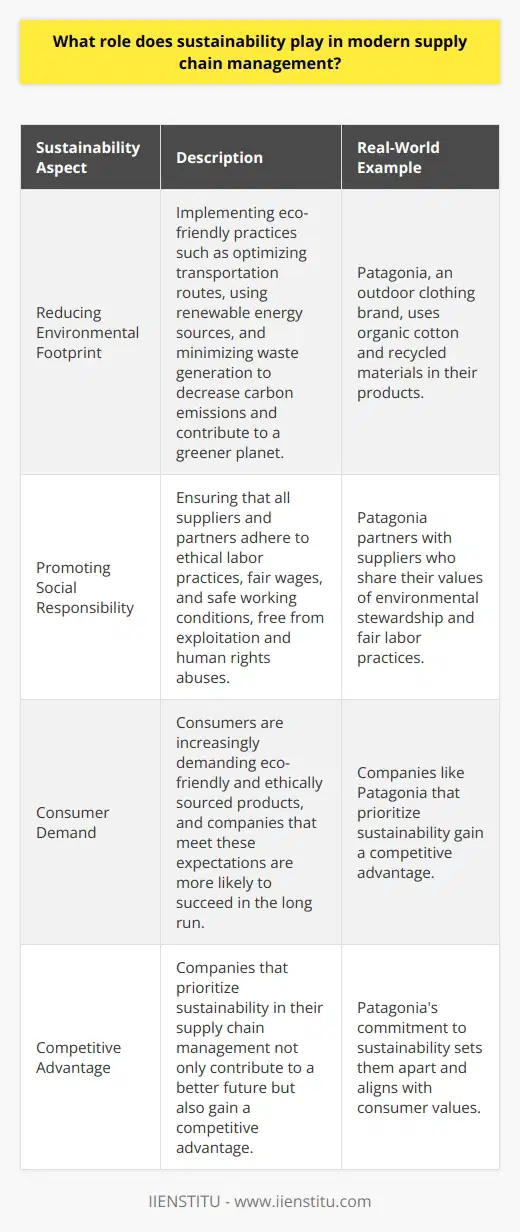
How do you foster a culture of continuous improvement within a supply chain organization?
As a supply chain leader, I believe in empowering my team to drive continuous improvement. I start by setting clear expectations and goals that align with the company's vision. Regular communication is key to keeping everyone engaged and motivated.
Encouraging Innovation
I encourage my team to think creatively and share their ideas for process enhancements. We have regular brainstorming sessions where no idea is too small or too big. I remember one team member suggesting a new inventory tracking system that ended up saving us thousands of dollars.
Celebrating Successes
When we achieve a milestone or implement a successful improvement, we celebrate as a team. This boosts morale and reinforces the importance of continuous improvement. Last quarter, we reduced our lead times by 15% and had a pizza party to recognize everyone's hard work.
Leading by Example
I believe in leading by example and actively participating in improvement initiatives. I'm not afraid to roll up my sleeves and work alongside my team. This shows that I'm invested in our success and value their contributions.
Continuous Learning
I'm always looking for opportunities to learn and grow, both personally and professionally. I attend industry conferences and workshops to stay updated on best practices and emerging trends. I then share this knowledge with my team to inspire them to keep learning and improving.
At the end of the day, fostering a culture of continuous improvement is about creating an environment where everyone feels valued, supported, and motivated to do their best work. It's a collaborative effort that requires open communication, trust, and a shared commitment to excellence.
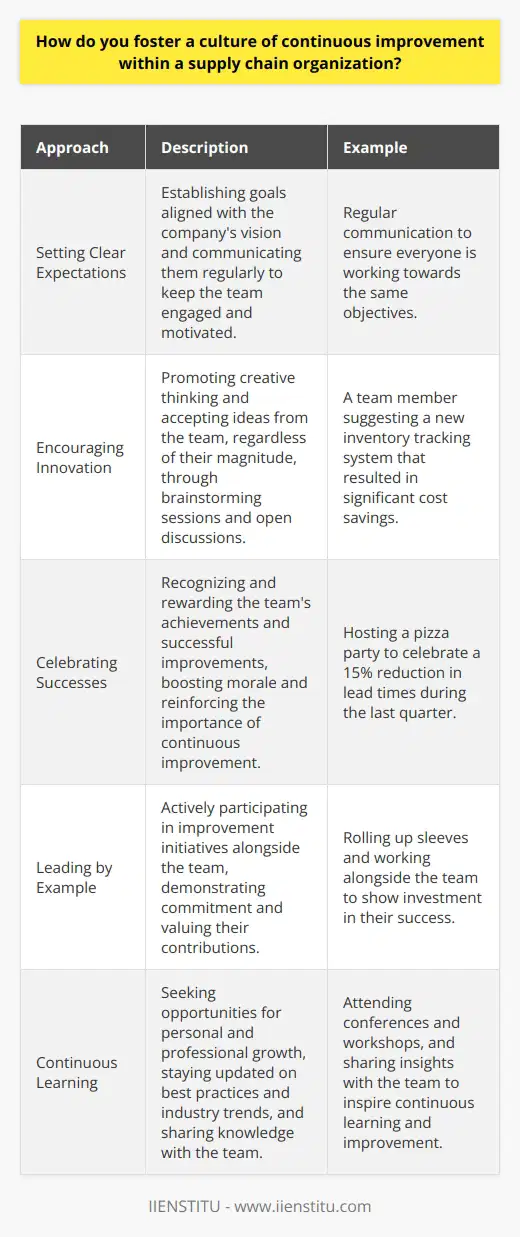
What are the advantages of implementing a vendor-managed inventory (VMI) system in a supply chain?
Implementing a vendor-managed inventory (VMI) system offers several advantages in a supply chain. First and foremost, it streamlines the ordering process. The vendor takes responsibility for monitoring and replenishing inventory levels, reducing the burden on the buyer.
Improved Efficiency and Cost Savings
VMI eliminates the need for the buyer to constantly check stock levels and place orders. This frees up time and resources that can be allocated to other critical tasks. Additionally, the vendor can optimize delivery schedules, leading to reduced transportation costs and improved efficiency.
Enhanced Collaboration and Communication
By implementing VMI, buyers and vendors establish a closer partnership. They collaborate more closely, sharing real-time data and insights. This enhanced communication helps identify potential issues early on and facilitates quick problem-solving.
Reduced Stock-Outs and Overstocking
With VMI, the vendor has access to accurate demand forecasts and inventory data. They can proactively adjust stock levels to prevent stock-outs and overstocking. This ensures that the right products are available when needed, improving customer satisfaction and reducing excess inventory costs.
Continuous Improvement and Innovation
VMI encourages continuous improvement and innovation in the supply chain. Vendors and buyers work together to identify inefficiencies, streamline processes, and explore new opportunities. This collaborative approach fosters a culture of continuous improvement, leading to long-term benefits for both parties.
In my experience, implementing VMI has been a game-changer. It has allowed us to focus on our core competencies while trusting our vendors to manage inventory effectively. The results have been impressive – reduced costs, improved customer service, and a more agile supply chain.
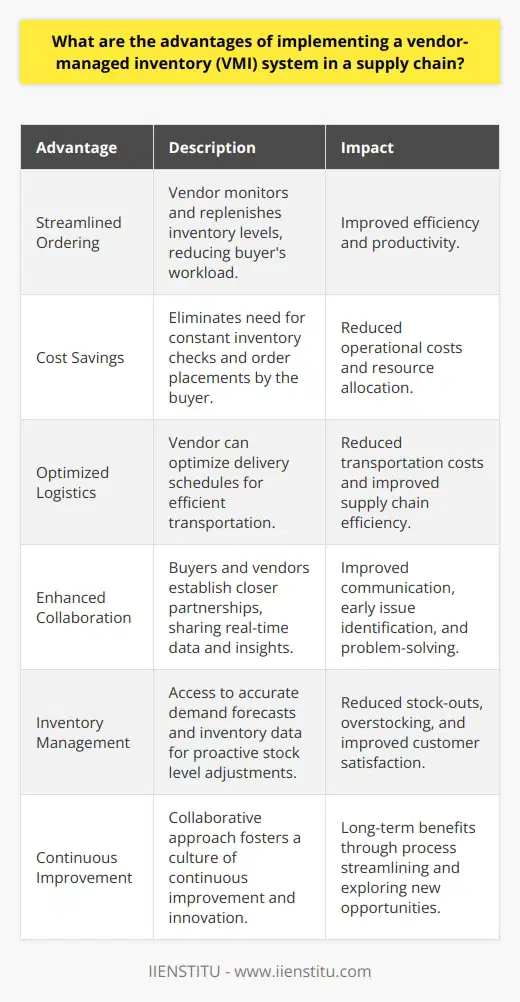
How can a company leverage supply chain analytics to gain a competitive advantage?
Supply chain analytics can give a company a competitive edge by providing valuable insights into their operations. By leveraging data from across the supply chain, businesses can identify areas for improvement and optimization. This allows them to reduce costs, improve efficiency, and better serve their customers.
Identifying Inefficiencies
One key way analytics helps is by pinpointing inefficiencies and bottlenecks in the supply chain. For example, data might show that certain suppliers consistently deliver late, causing production delays. Armed with this knowledge, the company could address the issue, perhaps by finding more reliable vendors.
Real-time Visibility
Analytics also provides real-time visibility into supply chain performance. Managers can track key metrics like inventory levels, shipping times, and more. This allows them to quickly spot and resolve issues before they escalate. I once worked for a manufacturer that used real-time analytics to great effect.
Forecasting Demand
Another major benefit is improved demand forecasting. By analyzing historical sales data and market trends, companies can better predict future demand. This helps them optimize inventory levels, reducing both stockouts and excess stock. No more guessing how much to order!
My Experience
In my last role, we implemented a new analytics platform and saw significant results. We were able to reduce our inventory carrying costs by 20% while actually improving service levels. It was a real win-win. I'm a big believer in the power of analytics done right.
Continuous Improvement
Finally, analytics enables continuous improvement by providing a feedback loop. Companies can test changes, measure the impact, and refine their approach over time. It's all about leveraging data to work smarter and stay ahead of the competition. That's been my experience and something I'm passionate about driving in any organization.
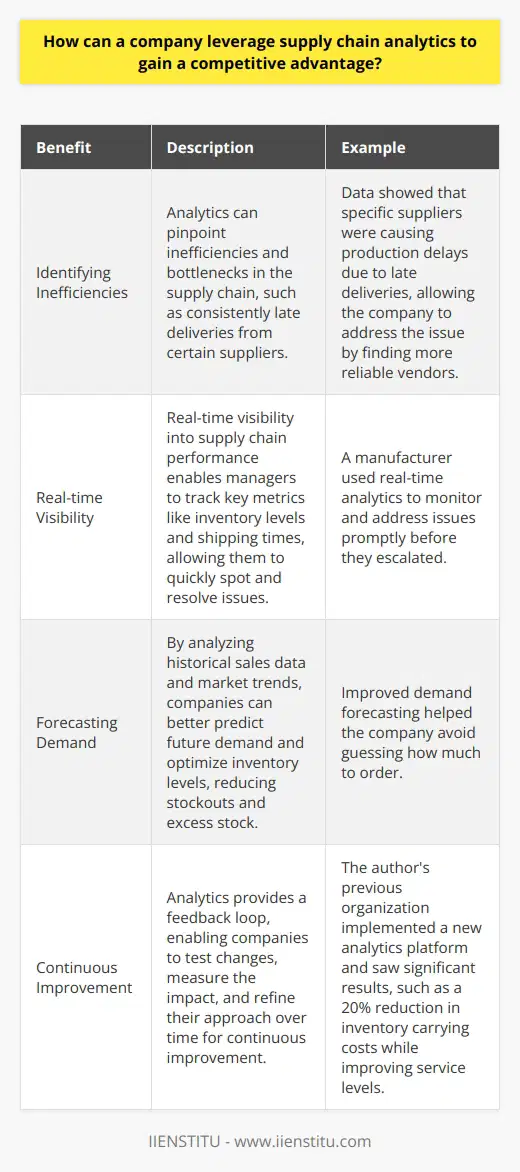
What are the key steps in developing an effective supply chain risk management plan?
<h3>Identify Potential Risks</h3><p>The first step is to identify all the potential risks that could disrupt your supply chain. This includes risks like natural disasters, labor strikes, supplier bankruptcies, geopolitical events, cyberattacks, and more. It's important to consider risks across the entire supply chain, from raw materials to finished goods delivery.
Assess Impact and Likelihood
The next step is to assess each risk in terms of the potential impact it could have on the business and the likelihood of it occurring. You can rank risks as low, medium, or high impact and probability. This allows you to prioritize the biggest threats. When I was working at Acme Industries, we used a risk matrix to map out and score each risk.
Develop Mitigation Strategies
For the highest priority risks, you need to develop mitigation strategies to reduce the impact or likelihood of disruption. Strategies can include diversifying suppliers, increasing inventory of critical parts, developing backup transportation plans, and improving security. The goal is to proactively implement countermeasures before disruption occurs.
Monitor and Review
Finally, supply chain risk management is an ongoing process. You have to continually monitor risks and review the effectiveness of your plan. As the risk landscape evolves, the plan needs to adapt. I believe that having clear metrics and holding regular status meetings is critical to staying on top of supply chain risks and keeping the plan up-to-date.
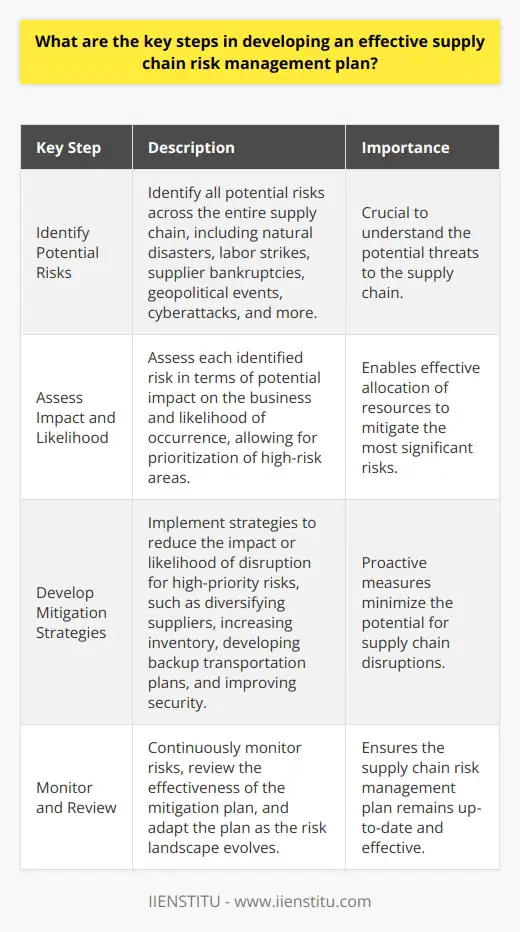
How do you align supply chain strategies with overall business objectives?
Aligning supply chain strategies with overall business objectives is crucial for success. I've found that effective communication and collaboration between departments is key. By clearly understanding the company's goals, the supply chain team can develop strategies that support those objectives.
Focus on Customer Needs
One important aspect is to always keep the customer's needs in mind. Whether it's improving delivery times or offering customization options, aligning the supply chain to meet customer expectations helps drive business growth. I remember a project where we redesigned our distribution network based on customer feedback, and it led to a significant increase in sales.
Embrace Technology and Innovation
Staying up-to-date with the latest supply chain technologies and innovations is also critical. By implementing tools like real-time inventory tracking and predictive analytics, we can optimize our processes and make data-driven decisions. I've seen firsthand how embracing automation can streamline operations and reduce costs, ultimately supporting the bottom line.
Foster a Culture of Continuous Improvement
Another strategy I believe in is fostering a culture of continuous improvement within the supply chain team. Encouraging employees to identify areas for optimization and share ideas leads to a more efficient and agile supply chain. It's about empowering people to take ownership and continuously seek ways to better align with business goals.
Collaborate with Strategic Partners
Building strong relationships with strategic partners, such as suppliers and logistics providers, is also key. By working closely with these partners and aligning our objectives, we can create a more resilient and responsive supply chain. I've found that regular communication and joint problem-solving sessions help ensure everyone is working towards the same goals.
Ultimately, aligning supply chain strategies with business objectives requires a holistic approach. It's about understanding the big picture, being proactive, and continuously adapting to changing market conditions. By doing so, the supply chain becomes a strategic asset that drives the company's success.
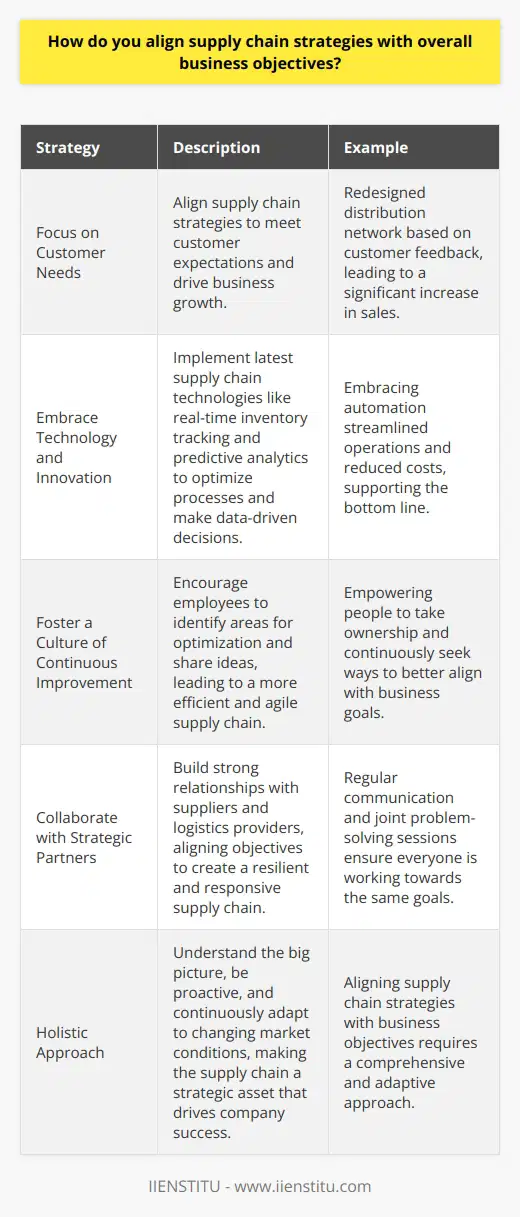
What are the best practices for managing cross-border supply chain operations?
Managing cross-border supply chain operations requires a comprehensive approach that takes into account various factors. Here are some best practices I've learned through my experience working in global logistics:
Develop a Strong Network of Local Partners
Building relationships with reliable suppliers, carriers, and customs brokers in each country is crucial. They provide valuable insights into local regulations, cultural norms, and business practices that can help you navigate complex cross-border challenges.
Prioritize Visibility and Transparency
Implementing technology solutions that provide real-time visibility into your supply chain is essential. This allows you to track shipments, monitor inventory levels, and quickly identify and resolve any issues that arise.
Invest in Risk Management
Cross-border operations are inherently risky, so it's important to have contingency plans in place. This might include diversifying your supplier base, carrying extra inventory, or purchasing insurance to mitigate potential disruptions.
Foster Open Communication and Collaboration
Encouraging open dialogue between all parties involved in your supply chain is key. Regular meetings, clear communication channels, and a willingness to work together can go a long way in ensuring smooth operations.
Stay Up-to-Date on Regulations and Compliance
Customs regulations, trade agreements, and other legal requirements are constantly evolving. Making sure you have a dedicated team or partner to stay on top of these changes is critical to avoid delays or penalties.
At the end of the day, managing cross-border supply chains is all about being proactive, adaptable, and willing to learn from experience. It's a continuous process of improvement that requires patience, creativity, and a bit of humor when things don't go exactly as planned!

How can a company optimize its warehousing and distribution processes within a supply chain?
To optimize warehousing and distribution processes within a supply chain, I believe a company should focus on several key areas. In my experience working in logistics, I've found that implementing the right technology can make a huge difference. For example, at my previous job, we used an automated inventory management system that significantly reduced errors and improved efficiency.
Streamline Warehouse Layout
Another important factor is streamlining the warehouse layout. By analyzing product flow and optimizing storage locations, companies can minimize travel time and increase productivity. I once helped redesign a warehouse floor plan, and we saw a 20% increase in picking speed as a result.
Implement Cross-Docking
Cross-docking is another strategy that can help optimize distribution. This involves transferring incoming goods directly to outbound vehicles, reducing storage time and handling costs. I've seen cross-docking work wonders for companies dealing with high-volume, fast-moving products.
Collaborate with Suppliers and Carriers
Building strong relationships with suppliers and carriers is also crucial. By collaborating closely and sharing information, companies can improve forecasting accuracy, reduce lead times, and ensure timely deliveries. In my opinion, open communication and trust are key to making these partnerships work.
Continuously Monitor and Improve
Finally, I think it's essential to continuously monitor performance metrics and look for opportunities to improve. Whether it's implementing new technologies, refining processes, or training employees, there's always room for growth. I get excited about finding ways to optimize operations and drive better results.
At the end of the day, optimizing warehousing and distribution is all about working smarter, not harder. By focusing on these areas and staying adaptable, I believe companies can create more efficient, effective supply chains that deliver real value to customers.

What are the most significant trends and innovations shaping the future of supply chain management?
The most significant trends and innovations shaping the future of supply chain management are automation, digitization, and sustainability. These developments are transforming how businesses operate and deliver value to customers.
Automation and Robotics
Automation is revolutionizing supply chain processes, from warehousing to transportation. Robots are increasingly used for tasks like picking, packing, and sorting. This boosts efficiency, reduces errors, and frees up human workers for higher-value tasks.
I remember visiting an Amazon fulfillment center and being amazed by the choreography of robots and humans working together. It was like a glimpse into the future of supply chain operations.
Digitization and Data Analytics
Digital technologies are providing unprecedented visibility and insights across the supply chain. IoT sensors, blockchain, and cloud computing enable real-time tracking of goods and information sharing among partners. Advanced analytics help optimize inventory, predict demand, and identify risks.
In my experience, embracing digital tools has been a game-changer. At my company, we implemented a cloud-based platform that gave us a unified view of our global supply chain. It allowed us to make data-driven decisions and respond quickly to disruptions.
Sustainability and Circular Economy
Sustainability is no longer just a buzzword but a business imperative. Companies are adopting eco-friendly practices like reducing waste, using renewable energy, and designing products for circularity. A circular supply chain keeps resources in use for as long as possible.
I believe that sustainability is not only the right thing to do but also a competitive advantage. Consumers are increasingly choosing brands that align with their values. By embedding sustainability into our supply chain strategy, we can build trust and loyalty with our customers.
In conclusion, automation, digitization, and sustainability are the key trends driving the future of supply chain management. Businesses that embrace these innovations will be well-positioned to thrive in the years ahead.

How do you measure and track the success of supply chain improvement initiatives?
When measuring and tracking the success of supply chain improvement initiatives, I focus on several key metrics. First and foremost, I look at cost savings achieved through optimizing processes and negotiating better contracts with suppliers. It's essential to quantify the financial impact of any changes made.
Next, I assess improvements in operational efficiency. This includes factors such as reduced lead times, increased inventory turns, and higher order fulfillment rates. By streamlining operations, we can deliver products to customers faster and more reliably.
Customer Satisfaction Metrics
Another critical aspect is monitoring customer satisfaction levels. I track metrics like on-time delivery percentages, order accuracy, and customer feedback scores. Happy customers are the ultimate goal of any supply chain improvement effort.
Collaboration and Communication
I also believe in fostering strong collaboration and communication among supply chain partners. I measure the frequency and quality of interactions with suppliers, logistics providers, and internal stakeholders. Regular meetings, information sharing, and joint problem-solving sessions are vital for driving continuous improvement.
Sustainability and Risk Management
Finally, I keep a close eye on sustainability and risk management indicators. This includes monitoring the carbon footprint of our supply chain, ensuring ethical sourcing practices, and proactively identifying and mitigating potential disruptions. By addressing these areas, we build a more resilient and responsible supply chain.
Ultimately, the success of supply chain improvement initiatives requires a holistic approach. By tracking a balanced set of metrics across cost, efficiency, customer satisfaction, collaboration, and sustainability, I can drive meaningful results and contribute to the overall success of the organization.
